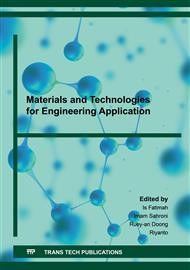[1]
S. Kumneadklang, S. Larpkiattaworn, C. Niyasom, S. O-Thong, Bioethanol Production from Oil Palm Frond by Simultaneous Saccharification and Fermentation, Energy Procedia. 79 (2015) 784–790.
DOI: 10.1016/j.egypro.2015.11.567
Google Scholar
[2]
C. Oktaviananda, R.F. Rahmawati, A. Prasetya, C.W. Purnomo, A.T. Yuliansyah, R.B. Cahyono, Effect of temperature and biomass-water ratio to yield and product characteristics of hydrothermal treatment of biomass, in: AIP Conf. Proc. 2017, p.020029.
DOI: 10.1063/1.4978102
Google Scholar
[3]
K. Weber, P. Quicker, Properties of biochar, Fuel. 217 (2018) 240–261.
Google Scholar
[4]
Y.Y. Gan, H.C. Ong, P.L. Show, T.C. Ling, W.H. Chen, K.L. Yu, R. Abdullah, Torrefaction of microalgal biochar as potential coal fuel and application as bio-adsorbent, Energy Convers. Manag. 165 (2018) 152–162.
DOI: 10.1016/j.enconman.2018.03.046
Google Scholar
[5]
Q.V. Bach, W.H. Chen, Y.S. Chu, Ø. Skreiberg, Predictions of biochar yield and elemental composition during torrefaction of forest residues, Bioresour. Technol. 215 (2016) 239–246.
DOI: 10.1016/j.biortech.2016.04.009
Google Scholar
[6]
Y.F. Huang, H. Te Sung, P. Te Chiueh, S.L. Lo, Microwave torrefaction of sewage sludge and leucaena, J. Taiwan Inst. Chem. Eng. 70 (2017) 236–243.
DOI: 10.1016/j.jtice.2016.10.056
Google Scholar
[7]
J. Li, Y. Li, Y. Wu, M. Zheng, A comparison of biochars from lignin, cellulose and wood as the sorbent to an aromatic pollutant, J. Hazard. Mater. 280 (2014) 450–457.
DOI: 10.1016/j.jhazmat.2014.08.033
Google Scholar
[8]
H. Jalayeri, F. Pepe, Novel and high-performance biochar derived from pistachio green hull biomass: Production, characterization, and application to Cu(II) removal from aqueous solutions, Ecotoxicol. Environ. Saf. 168 (2019) 64–71.
DOI: 10.1016/j.ecoenv.2018.10.058
Google Scholar
[9]
A. Rodríguez-Vila, H. Selwyn-Smith, L. Enunwa, I. Smail, E.F. Covelo, T. Sizmur, Predicting Cu and Zn sorption capacity of biochar from feedstock C/N ratio and pyrolysis temperature, Environ. Sci. Pollut. Res. 25 (2018) 7730–7739.
DOI: 10.1007/s11356-017-1047-2
Google Scholar
[10]
C. Wang, H. Wang, Y. Cao, Pb(II) sorption by biochar derived from Cinnamomum camphora and its improvement with ultrasound-assisted alkali activation, Colloids Surfaces A Physicochem. Eng. Asp. 556 (2018) 177–184.
DOI: 10.1016/j.colsurfa.2018.08.036
Google Scholar
[11]
M. Naswir, S. Arita, Marsi, Salni, Treatment of Peat Water Using Local Raw Material Formulations of Jambi, Indonesia, Asian J. Chem. 27 (2015) 3951–3955.
DOI: 10.14233/ajchem.2015.18963
Google Scholar
[12]
J.H.M. Wösten, E. Clymans, S.E. Page, J.O. Rieley, S.H. Limin, Peat-water interrelationships in a tropical peatland ecosystem in Southeast Asia, Catena. 73 (2008) 212–224.
DOI: 10.1016/j.catena.2007.07.010
Google Scholar
[13]
C. Trigo, L. Cox, K. Spokas, Influence of pyrolysis temperature and hardwood species on resulting biochar properties and their effect on azimsulfuron sorption as compared to other sorbents, Sci. Total Environ. 566–567 (2016) 1454–1464.
DOI: 10.1016/j.scitotenv.2016.06.027
Google Scholar
[14]
A. Hanoğlu, A. Çay, J. Yanık, Production of biochars from textile fibres through torrefaction and their characterisation, Energy. (2019) 664–673.
DOI: 10.1016/j.energy.2018.10.123
Google Scholar
[15]
M. Rajabzadeh, H. Aghaie, H. Bahrami, Thermodynamic study of Iron (III) removing by the synthesized α-Alumina powder and evaluating the corresponding adsorption isotherm models using Response Surface Method, Arab. J. Chem. (2019).
DOI: 10.1016/j.arabjc.2019.07.006
Google Scholar
[16]
G. Hodaifa, J.M. Ochando-Pulido, S. Ben Driss Alami, S. Rodriguez-Vives, A. Martinez-Ferez, Kinetic and thermodynamic parameters of iron adsorption onto olive stones, Ind. Crops Prod. 49 (2013) 526–534.
DOI: 10.1016/j.indcrop.2013.05.039
Google Scholar
[17]
A. Abdolali, H.H. Ngo, W. Guo, S. Lu, S.S. Chen, N.C. Nguyen, X. Zhang, J. Wang, Y. Wu, A breakthrough biosorbent in removing heavy metals: Equilibrium, kinetic, thermodynamic and mechanism analyses in a lab-scale study, Sci. Total Environ. 542 (2016) 603–611.
DOI: 10.1016/j.scitotenv.2015.10.095
Google Scholar
[18]
M. Calero, A. Pérez, G. Blázquez, A. Ronda, M.A. Martín-Lara, Characterization of chemically modified biosorbents from olive tree pruning for the biosorption of lead, Ecol. Eng. 58 (2013) 344–354.
DOI: 10.1016/j.ecoleng.2013.07.012
Google Scholar
[19]
R. Tabaraki, A. Nateghi, Multimetal biosorption modeling of Zn2+, Cu2+ and Ni2+ by Sargassum ilicifolium, Ecol. Eng. 71 (2014) 197–205.
DOI: 10.1016/j.ecoleng.2014.07.031
Google Scholar
[20]
C. Chen, Evaluation of Equilibrium Sorption Isotherm Equations, Open Chem. Eng. J. 7 (2013) 24–44.
Google Scholar
[21]
Y.-S. Ho, Selection of optimum sorption isotherm, Carbon N. Y. 42 (2004) 2115–2116.
DOI: 10.1016/j.carbon.2004.03.019
Google Scholar
[22]
R. Rinaldi, Y. Yasdi, W.L.C. Hutagalung, Removal of Ni (II) and Cu (II) ions from aqueous solution using rambutan fruit peels (Nephelium lappaceum L.) as adsorbent, in: AIP Conf. Proc., 2018: p.020098.
DOI: 10.1063/1.5065058
Google Scholar
[23]
Y.S. Ho, R. Malaryvizhi, Equilibrium isotherm studies of methylene blue adsorption onto activated carbon prepared from Delonix regia pods, J Env. Prot Sci. 3 (2009) 111–116.
Google Scholar


